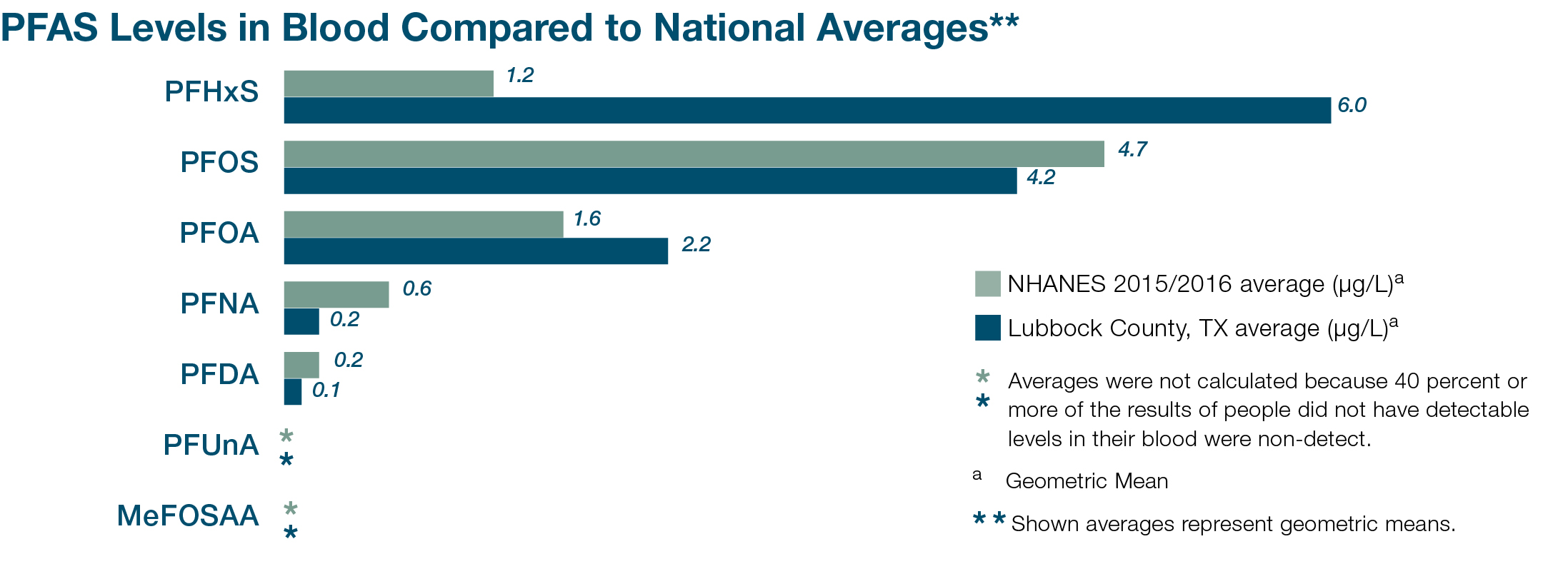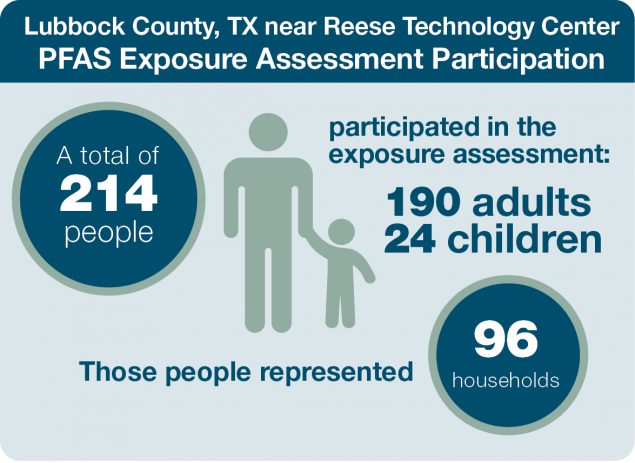CDC/ATSDR PFAS Exposure Assessment Community Level Results
Lubbock County (TX) near Reese Technology Center
INFORMATION TO PROTECT OUR COMMUNITIES
In 2019, the Centers for Disease Control and Prevention (CDC) and the Agency for Toxic Substances and Disease Registry (ATSDR) started exposure assessments (EAs) in communities near current or former military bases known to have had per- and polyfluoroalkyl substances (PFAS) in their drinking water. Individuals who participated in the EAs provided blood and urine samples to CDC/ATSDR for analysis. We sent letters with lab results to the participants. An example letter of the test results is available here pdf icon[PDF – 390 KB].
We are also reviewing additional information, like age and location, to better understand the community’s exposure. Once our full analysis is complete, CDC/ATSDR will host a community meeting to share our findings and recommendations.
The Lubbock County, TX EA site focused on an area near Reese Technology Center. A map of the sampling area can be found at: www.atsdr.cdc.gov/pfas/activities/assessments/sites/lubbock-county-tx.html
The lab tested participants’ blood for 7 different PFAS. PFAS levels are measured in micrograms per liter (µg /L).
CDC/ATSDR compared the levels of PFAS in participant’s blood across the community to the levels found in the U.S. population. Two PFAS, PFHxS and PFOA) were detected above national averages. The levels of MeFOSAA, PFOA, PFUna, PFNA, and PFDA were similar to or below national averages.
Since 1999, the National Health and Nutrition Examination Survey (NHANES) has measured PFAS levels in blood in the U.S. population. Most people in the United States have been exposed to PFAS and have PFAS in their blood.

The numbers below show the percentage of participants with PFAS levels above the national average.
PFAS Levels in Blood Compared to Other Studies**




PFAS Levels in Urine:
All participants provided a urine sample, some of the samples were analyzed. PFBA and PFHxA were detected at low concentrations in 5% and 9% of the samples, respectively. Averages were not calculated because PFAS were only found in a small number of samples.
PFAS Levels in Tap Water:
CDC/ATSDR collected and tested tap water samples from some participating households. PFAS levels for all 12 tap water samples were below all federal and applicable state guidelines for PFAS in drinking water.
PFAS Levels in Dust:
CDC/ATSDR collected and analyzed indoor dust samples from 12 participating households. CDC/ATSDR is evaluating the dust sample results and will have more information in the final report.
About the Results:
CDC/ATSDR is evaluating data collected from the PFAS EA to better understand exposure in the community. The PFAS EA measures PFAS levels in people’s bodies but is not able to identify health effects associated with these levels of exposure. We are working to better understand health effects from PFAS exposure through the Multi-site Health Study www.atsdr.cdc.gov/pfas/Multi-Site-Health-Study.html.
We are also reaching out to doctors, nurses, and other health care providers in your area to provide PFAS information. PFAS clinician guidance and continuing medical education can be found at https://www.atsdr.cdc.gov/pfas/docs/clinical-guidance-12-20-2019.pdfpdf icon.
For More Information:
Visit www.atsdr.cdc.gov/pfas
or contact: Captain Patrick Young,
ATSDR Region 6
pay9@cdc.gov or 214-665-8562

